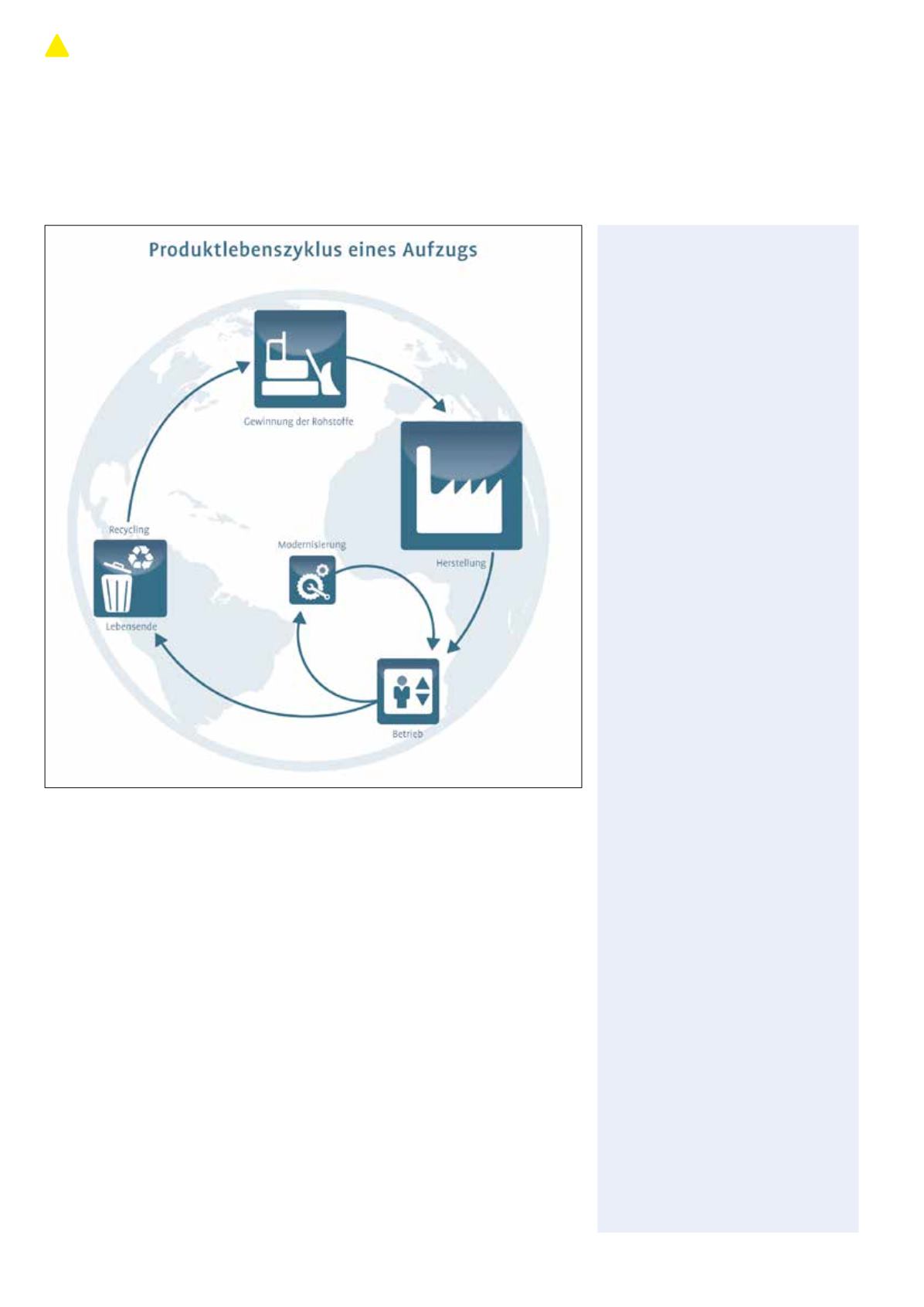

80
LIFT
journal 5/2017
GlaubenSie,mit einemNeuwagenkauf zum
Klimaschutz beizutragen? Erst nach über
300 000 Kilometern verbessern wir die CO₂-
Bilanz – und auch das nur, falls der Neue
nicht nur im Prospekt, sondern auch auf
der Straße mindestens einen Liter weniger
verbraucht als der Alte. So ähnlich verhält
es sich auch bei Aufzügen.
Derzeit wird der Energiebedarf im Betrieb
gerne als alleiniges Kriterium für die Ener-
gieeffizienz herangezogen. Die Realität
indes ist deutlich komplexer – das öko-
logische Optimierungspotenzial ist durch
diese eingeschränkte Sichtweise noch
lange nicht ausgeschöpft. Um ein Produkt
auf seine ökologische Nachhaltigkeit hin
beurteilen zu können, muss man seinen
gesamten Lebenszyklus betrachten und
sich auch mit grauer Energie auseinander-
Energieeffizienz – gut oder nur gut gemeint?
Energy efficiency – good or only well-meant?
setzen.Als graue Energie wird die gesamte
Menge nicht erneuerbarer Primärenergie
bezeichnet, die für alle vor- und nachge-
lagerten Prozesse aufgewendet wird. Dort
versteckt sich ein großer, häufig unbeach-
teter Teil unseres Energieverbrauchs. Die
Energiekosten im laufenden Betrieb hin-
gegen fallen, wenn man den Blickwinkel
aufs Ganze ausweitet, nur noch wenig ins
Gewicht. Für eine signifikante Reduktion
des Gesamtenergieverbrauchs gilt es je-
doch, das enorme Potenzial des effizienten
Einsatzes von Rohstoffen und einer langen
Lebensdauer von Produkten zu erkennen
und auszuschöpfen.
Modernisierung stattWegwerfkultur
Unternehmen, die sich ihrer ökologischen
Verantwortung stellen, müssen anerken-
nen, dass das Streben nach Energieeffizienz
Do you think you are contributing to en-
vironmental protection by buying a new
car? We improve the CO₂ balance sheet
only after 300,000 kilometres – and then
only if the new car actually consumes
at least a litre less in reality than the old
one on the street instead of just in the
brochure. The situationwith lifts is similar.
Currently, the energy requirement in the company
is usually taken as the sole criterion for energy ef-
ficiency.The reality is in fact farmore complex - the
ecological optimisation potential is far frombeing
exhausted by this narrow point of view. In order
to be able to evaluate the ecological sustainability
of a product, its entire life cycle must be consid-
ered and allowance made for ‘grey energy’. ‘Grey
energy’ is the total quantity of non-renewable
primary energy used for all up- and downstream
processes. This represents a large, frequently
overlooked portion of our energy consumption.
By contrast, the energy costs in operation are
relatively unimportant when one considers the
whole picture. However, in order to reduce overall
energy consumption significantly, what counts is
recognising and exploiting the enormous poten-
tial of the efficient use of raw materials and the
long service life of products.
Modernisation instead of throwaway culture
Companies that face up to their ecological re-
sponsibility have to recognise that striving after
energy efficiency only makes up a small part of a
higher resource efficiency strategy. In the case of
multi-family buildings and blocks of rented flats, a
service life of 60 – 85 years is assumed, in the case
of a lift just 15 – 20 years. Therefore, to evaluate
resource efficiency or sustainability, the entire life
cycle of a building and not just the life cycle of the
lift should be considered.
But in order to be energy efficient in operation
too, it is important to find the right drive in the
planning phase for the particular application.
Bucher Hydraulics provides the support required
for this in all phases of planning and develop-
ment. The advice ranges from the first important
step – thorough analysis of the lift data – to
presenting various possible solutions and de-
ploying the corresponding tools to visualise the
energy requirement. The important parameters
for energy efficiency in the operational phase are
energy consumption during the trip and energy
consumption in standby mode. Many years of
experience and the specialist expertise of the lift
partner are the key here to individual modernisa-
tion packages.
More sustainable with hydraulics
If you make sustainability in planning the lift to
the decisive criterion – i.e. not just energy ef-
ficiency during operation - a hydraulic solution is
unavoidable. A decisive contribution to reducing
Abbildung 1: Darstellung des kleinen Einflusses von Modernisierung auf den ökologischen Fuß
abdruck /
Figure 1: Presentation of the small influence of modernisation on the ecological footprint
Bucherhydraulics (2)
PERSPEKTIVEN /
PERSPECTIVES
















